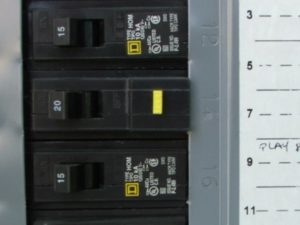
”GFI” is slang for ”GFCI” an acronym for Ground Fault Circuit Interrupter. These are the receptacles with the funny little buttons on the front of them that are pushed to test and reset the device. They are a safety device to detect a ground fault or an imbalanced load on a circuit. An unintentional electrical path between a source of current and a grounded surface is referred to as a ground fault. When there is a current leak and how it leaks is very important. If you provides that path, you can be shocked or worse. Adding GFCI outlets/breakers in all appropriate locations is very inexpensive and can save a life.
The GFCI outlet/breaker constantly monitors current flowing in a circuit to sense any loss/imbalance of current. If the current flowing through the black and white wires differs by a very very very small amount (5 milliamps), current is almost instantly (1/13second) interrupted and will stop the flow of electricity through your body to reach ground and prevent serious injury. According to the Consumer Product Safety Commission (CPSC), there are still approximately 300 electrocutions per year that could be prevented with the installation of these protection devices. Have you ever touched an appliance and got shocked? That is stray current that has gone through your body to find ground.
For use in wet locations
GFCI devices are intended for use in “wet locations” like bathrooms, garages, kitchens, wet bars, utility rooms, on the exterior of the house and in the few basements in Florida. The Consumer Product Safety Commission also recommends them for use on power tools. You should also find them on spas, hot tubs, pumps and on lighting/receptacles in the vicinity. Some older pools and pool lighting may not be protected and are thus a potential source of electrocution. Keep in mind that a GFCI receptacle does not protect against circuit overloads, short circuits or shocks, but AFCI breakers can.
| NEC req’ | Bath | Exterior | Garage | Kitchen |
| 1975 | X | X | ||
| 1978 | X | X | X | |
| 1981 | X | X | X | |
| 1984 | X | X | X | |
| 1987-now | X | X | X | X |

When were GFCIs required?
The first use of these devices, according to the CPSC, was in 1973 but that broad use and enforcement, according to other sources I checked, began in 1978 but who’s arguing. If you don’t have them, install them, they’re cheap. About $8 from those great big stores that sell a bunch of building materials. The locations and years required is illustrated in the attached chart.
The most common types of GFCIs are the receptacles themselves (outlets with the funny buttons) and circuit breakers (breakers with the funny buttons). Installation, though easy, should be done by an electrician. GFCIs do go bad and you can even purchase bad GFCIs. Small plug in circuit testers are also available at home improvement stores for less than $10. I have found many receptacles whose button has popped out but still has current flowing through it! There are some types on the market that will help eliminate such occurrences.
Now keep in mind, if you are rehabbing a kitchen and changing out cabinets and counter tops, most municipalities require that a permit be pulled and electrical standards brought current (pun intended). If you are rehabbing a pre-1960 house that has the old 2 wire system (no ground), building standards allow you to install a GFCI device at the first receptacle on a circuit to protect everything else down stream. Very cool because that’s very cheap. Rewiring a house will run you thousands!
Check out our company website, www.inspectagator.com. We have a lot of great videos on our Youtube channel, https://www.youtube.com/user/inspectagator/videos?view_as=subscriber Our facebook page is full of information and short videos, https://www.facebook.com/theinspectagator/
